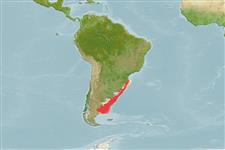Élasmobranches (requins et raies) (sharks and rays) >
Carcharhiniformes (Ground sharks) >
Triakidae (Houndsharks) > Triakinae
Etymology: Mustelus: Latin for weasel, an ancient name for sharks, possibly referring to the pointed snouts, swift movements and/or rapacious feeding behavior of smaller predatory sharks [strictly not tautonymous with Squalus mustelus Linnaeus 1758 since type was designated by the ICZN] (See ETYFish); schmitti: In honor of American biologist Waldo L. Schmitt (1887-1977), curator of marine invertebrates at the U.S. National Museum, who collected holotype (See ETYFish).
Eponymy: Dr Waldo LaSalle Schmitt (1887–1977) was an expert on crustaceans who worked at the Smithsonian (1915–1957). [...] (Ref. 128868), visit book page.
Environment: milieu / climate zone / profondeur / distribution range
Écologie
marin démersal; océanodrome (Ref. 51243); profondeur 60 - 195 m (Ref. 27770). Subtropical; 28°S - 45°S, 66°W - 46°W (Ref. 244)
Southwest Atlantic: southern Brazil to northern Argentina.
Length at first maturity / Taille / Poids / Âge
Maturité: Lm 58.3, range 55 - 62 cm
Max length : 92.0 cm TL mâle / non sexé; (Ref. 57911); common length : 60.0 cm TL mâle / non sexé; (Ref. 6077)
Found on the continental shelf. Feeds on crabs and probably other crustaceans, and presumably small fishes. Ovoviviparous (aplacental) with 2 to 7 pups per litter. Size at birth 26 cm. Utilized for human consumption.
Ovoviviparous, embryos feed solely on yolk (Ref. 50449). Distinct pairing with embrace (Ref. 205).
Compagno, L.J.V., 1984. FAO Species Catalogue. Vol. 4. Sharks of the world. An annotated and illustrated catalogue of shark species known to date. Part 2 - Carcharhiniformes. FAO Fish. Synop. 125(4/2):251-655. Rome: FAO. (Ref. 244)
Statut dans la liste rouge de l'IUCN (Ref. 130435: Version 2025-1)
Menace pour l'homme
Harmless
Utilisations par l'homme
Pêcheries: hautement commercial
Outils
Articles particuliers
Télécharger en XML
Sources Internet
Estimates based on models
Preferred temperature (Réf.
123201): 4.5 - 14.2, mean 7.9 °C (based on 118 cells).
Phylogenetic diversity index (Réf.
82804): PD
50 = 0.5000 [Uniqueness, from 0.5 = low to 2.0 = high].
Bayesian length-weight: a=0.00257 (0.00166 - 0.00398), b=3.10 (2.97 - 3.23), in cm total length, based on LWR estimates for this species & Genus-body shape (Ref.
93245).
Niveau trophique (Réf.
69278): 3.6 ±0.3 se; based on diet studies.
Generation time: 18.0 ( na - na) years. Estimated as median ln(3)/K based on 2
growth studies.
Résilience (Réf.
120179): Très faible, temps minimum de doublement de population supérieur à 14 ans (Fec=2-3).
Fishing Vulnerability (Ref.
59153): High vulnerability (58 of 100).
🛈
Climate Vulnerability (Ref.
125649): Very high vulnerability (87 of 100).
🛈
Nutrients (Ref.
124155): Calcium = 22.3 [6.0, 110.4] mg/100g; Iron = 0.517 [0.160, 1.927] mg/100g; Protein = 21.7 [19.4, 24.0] %; Omega3 = 0.143 [0.059, 0.338] g/100g; Selenium = 38.2 [11.0, 135.0] μg/100g; VitaminA = 7.36 [2.55, 20.30] μg/100g; Zinc = 0.638 [0.282, 1.271] mg/100g (wet weight);
